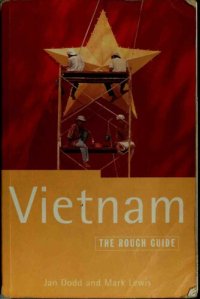
Ebook: Vietnam: The Rough Guide
Author: Mark Lewis Jan Dodd
- Series: Rough Guide
- Year: 1998
- Publisher: Rough Guides
- Edition: 2
- Language: English
- pdf
History weighs heavily on Vietnam. For more than a decade, reportage of the war that racked this slender country portrayed it as a netherworld of savagery and slaughter; and even after the American War ended it was further pigeon-holed by Hollywoods seamless chain of combat movies. Yet, only twenty-odd years after the wars end, this incredibly resilient nation is beginning to emerge from the shadows: access is now easier than ever, and the country has re-invented its old-style communist system as a free market economy that encourages contact. As the number of tourists finding their way here soars, the word is out that this is a land not of bomb craters and army ordnance, but of shimmering paddy fields and sugar-white beaches, full-tilt cities and venerable pagodas often overwhelming in its sheer beauty.
The speed with which Vietnams population of some 77 million has been able to put the bitter events of its recent past behind it, and focus its gaze so steadfastly on the future, comes as a surprise to visitors expecting to encounter shell-shocked resentment of the West and war fatigue. It wasnt always like this, however. The reunification of North and South Vietnam that ended twenty years of bloody civil war, in 1975, was followed by a decade or so of hardline centralist economic rule from which only the shake-up of doi moi, Vietnams equivalent of perestroika, could awaken the country. By lifting the lid off private enterprise, doi moi has, since its conception in 1986, signalled a renaissance for Vietnam, and today a high fever of commerce grips the nation, as citizens clamour to claim their slice of the pie while the good times roll. Needless to say, the shift to a market economy would have been only notional without accompanying shifts in international relations in particular 1994s ending of the US trade embargo, which released the log jam of foreign investment; and the diplomatic rehabilitation that ensued once Vietnamese forces were pulled out of Cambodia in 1989, culminating in the restoration of US-Vietnamese diplomatic relations in July 1995. From a tourists point of view, its a great time to come thanks to an intoxicating sense of vitality and optimism, not to mention the chance to witness a country in profound flux. Whats more, after a decade and a half of isolation, theres a huge warmth and curiosity shown toward visitors by the Vietnamese, who tend to pounce voraciously on any chance to interact with foreigners.
Inevitably, thats not the whole story. Doi moi is an economic policy, not a magic spell, and life, for most of the population, remains hard. Indeed, doi moi has introduced its own problems, with the adoption of a market economy predictably polarizing the gap between rich and poor. Despite the numerous Japanese, Taiwanese and Korean assembly plants springing up, average monthly incomes for city dwellers remain at around US$50, while in the poorest provinces workers may scrape by on as little as US$15 a month a difference that amply illustrates the growing gulf between urban and rural Vietnam.
As you might expect, the long-standing antipathy and deep psychological divide between the north and south endures. This was around long before the American War, and is engrained in the bedrock of Vietnamese culture. Northerners are typically considered reticent, dour, law-abiding, and lacking the dynamism and entrepreneurial know-how of their more worldly-wise southern compatriots. A cartoonists caricature of a southerner would most likely depict a flashy wheeler-dealer, shades on, barking into a mobile phone as he weaves his Honda Dream through the busy streets; while his northern counterpart would appear in green army tunic and helmet, tootling along on his duck-laden bicycle.
Many visitors find more than enough to amuse them in Hanoi, Ho Chi Minh City and the other major centres; but despite the cities allure, its the countrys striking landscape that most impresses. Vietnam occupies a narrow strip of land that hugs the eastern borders of Cambodia and Laos, hemmed in by rugged mountains to the west, and by the South China Sea to the east. To the north and south of its narrow waist, it dovetails out into the splendid deltas of the Red River and the Mekong, and its in these regions that youll encounter the paddy fields, dragonflies, buffaloes and conical-hatted farmers that constitute the classic image of Vietnam. In stark contrast to the pancake-flat riceland of the deltas, Ha Long Bays labyrinthine network of limestone outcrops loom dramatically out of the Gulf of Tonkin a magical spectacle in the early morning mist. None of Vietnams mountains reach particularly impressive heights, so any trip to the remote upland regions of central and northern Vietnam is far likelier to focus upon the ethnic minorities who reside there. Elaborate tribal costumes, age-old customs and communal longhouses await those visitors game enough to trek into the sticks though if youre fortunate enough to sample the legendary hilltribe hospitality, you may find that the knockout rice wine they brew leaves memories hazy. As for wildlife, the discovery, in the early Nineties, of a previously unknown species of ox, the saola, speaks volumes for the wealth of Vietnams biodiversity that, despite the decade-long pasting the country received from American bombers and makes the improving access to the countrys several national parks all the more gratifying.